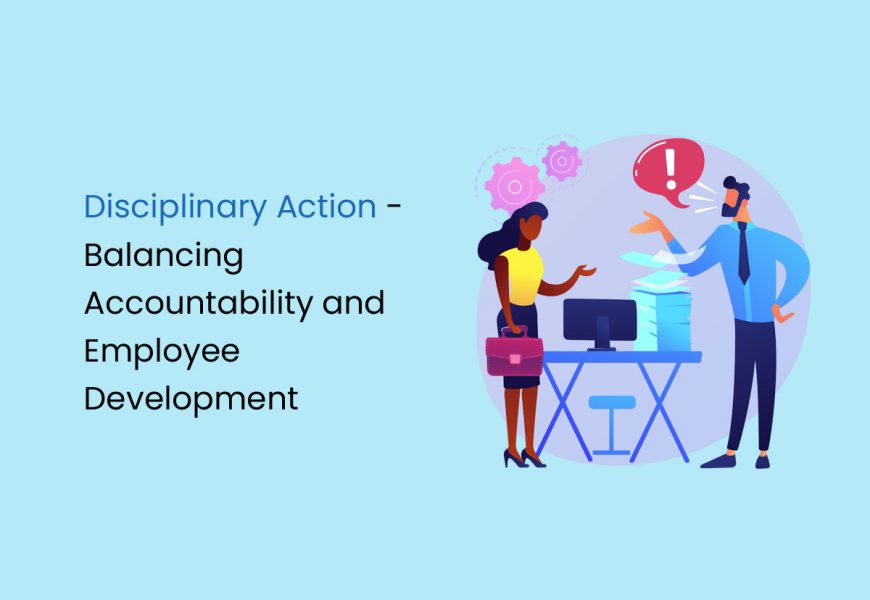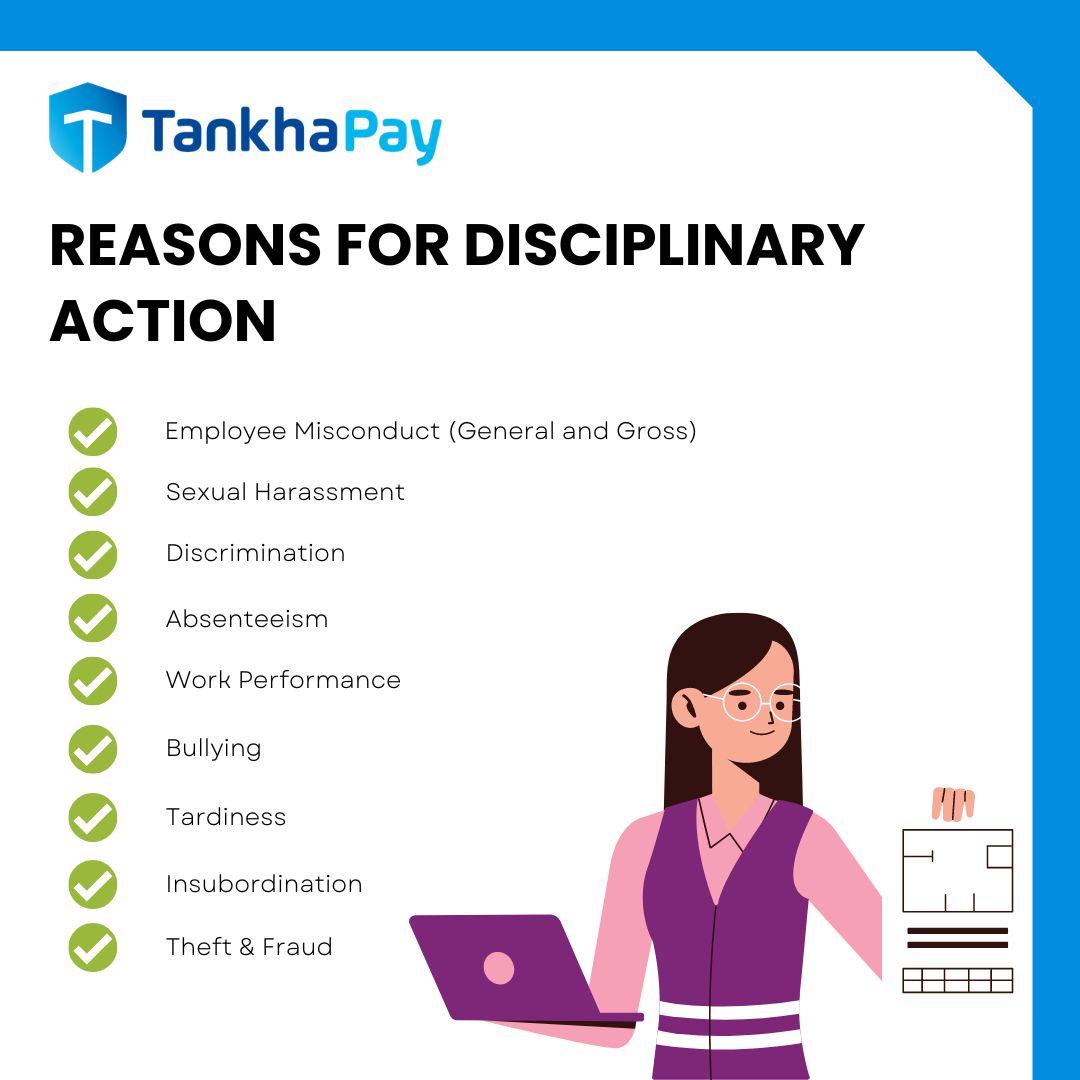Disciplinary actions play a crucial role in maintaining a healthy and productive workplace. When appropriately used, they can help address issues, promote accountability, and encourage a positive organisational culture. Knowing when to use disciplinary action and how to implement it can ensure that the company and its employees reap the most benefits.
What is a Disciplinary Action?
Disciplinary action is taken against employees who do not follow the organisation’s policies and regulations. This non-compliance can be regular misconduct, misbehaviour, poor performance, and violation of rules. The goal of disciplinary action is to correct employee behaviour, not to punish them.
Importance of Disciplinary Action
Disciplinary action is a significant part of the workplace to ensure employees are held accountable for misconduct, unsatisfactory performance, and breaking workplace rules.
Disciplinary actions can be time-consuming. Hence, less severe offences are usually handled through a meeting with a supervisor or a verbal warning. However, a formal approach is needed to address unprofessional behaviour effectively in case of serious infractions, and the company’s disciplinary procedure must be followed.
Reasons for Disciplinary Action
Some behaviours that can lead to disciplinary action being taken against an employee are as follows:
- Employee Misconduct (General and Gross)
- Sexual Harassment
- Discrimination
- Absenteeism
- Work Performance
- Bullying
- Tardiness
- Insubordination
- Theft
- Fraud
- Violation of Safety Protocols
Types of Disciplinary Action
The different types of disciplinary actions that can taken against an employee are as follows:
- Verbal Warning: A verbal warning is issued when an employer is unsatisfied with an employee’s performance or behaviour. It is generally given for a first or minor violation.
- Written Warning: It is usually a written document that informs the employee of their misconduct. It also includes the possible consequences if employees do not fix their conduct.
- Loss of Privileges: Poor employee behaviour may be linked to privileges, such as reckless driving, overspending, and rowdy conduct at business events. Organisations can revoke such privileges to prevent similar issues in the future.
- Performance Improvement Plan (PIP): In some cases, an employee with a negative performance review may be placed on a PIP as the first step towards improvement. The purpose of a PIP is to establish clear goals and objectives that the employee must meet to avoid being transferred, demoted, or terminated.
- Retraining: Retraining may be needed if employees struggle with their job duties. This can include reviewing policies and procedures and taking tests or courses. The goals should be specific and communicated.
- Demotion: A demotion is when an employee’s job title, role, or responsibilities are lowered. It can be permanent or temporary and is often used instead of firing. However, demotions can negatively impact an employee’s motivation and performance, so employers should carefully consider their effectiveness.
- Temporary Pay Cut: A pay cut is a reduction in employee compensation, including salary, benefits, or hours. It must comply with federal and local laws, making it a tricky disciplinary measure.
- Suspension: A disciplinary suspension is when an employee is asked not to come to work or engage in work-related activities. Usually, the employee is paid during this time. This happens when someone is under HR investigation and asked to step away from work until the investigation is complete.
- Termination: Termination is the last option if previous disciplinary actions fail or gross misconduct occurs. Each country has unique dismissal procedures and protections for employees.
How to Approach Disciplinary Action
There are several methods of employee disciplinary action that an organisation may use. They are:
- Progressive Discipline: Progressive discipline is a popular corrective method in the workplace. It involves issuing increasingly severe disciplinary actions if an employee fails to improve. This method includes regular check-ins and measurable goals. Progressive discipline protects organisations against legal action and provides employees opportunities to improve. However, it may not be suitable for serious violations that require immediate action.
- Positive Discipline: Positive discipline emphasises positive aspects of employee behaviour. It involves constructive criticism, employee participation, and positive reinforcement. It is used to prevent misbehaviour and reward employees who make positive changes. Though positive discipline is preferred, other disciplinary actions are taken when necessary.
- Suspensions or Reassignment: Suspension or reassignment happens for severe behavioural issues or conflicts that don’t warrant termination. Reassignment means retraining or placing the employee in a different work environment. Suspension means temporarily removing the employee from the workplace without pay.
What is a Company Disciplinary Procedure?
The disciplinary process is a structured way of addressing and resolving misconduct issues. A company disciplinary procedure is a formal way to ensure the disciplinary process is effective, consistent and fair. As everyone knows what to expect and is treated fairly, it helps employees and employers get the most out of the discipline.
The formal disciplinary procedure should be clearly outlined in a company policy and included in the employee handbook to ensure all employees know the procedures to follow.
The Procedure
The disciplinary procedure is as follows:
- HR Notification of Misconduct: HR plays an integral role in addressing and rectifying employee misconduct. The notification process involves identifying and documenting the misconduct, complying with legal and company policies, and initiating appropriate disciplinary actions.
- The Disciplinary Investigation: The first step of the process is to investigate and verify any allegations of unprofessional behaviour before escalating the matter. It also helps determine whether to start a disciplinary hearing or pursue an informal solution.
- Disciplinary Hearing Invitation: This is a formal and essential step in the disciplinary process. The employer or HR department is usually the one who invites the employee with a clear understanding of the issues and a chance to present their side, evidence, and witnesses at the hearing.
- The Disciplinary Hearing: Disciplinary hearings are held to address employee misconduct. The employer should provide evidence from both sides in a confidential hearing. The Acas Code of Practice outlines steps to be followed. Once all evidence is reviewed, HR representatives should assess the case and decide the outcome outside the hearing.
- Disciplinary Outcome: After the hearing, the employer can decide what, if any, disciplinary action should be taken. Some of the decisions that an employer may make after following the company disciplinary procedure are as follows:
- Taking no action
- Giving a verbal warning
- Giving a written warning
- Writing a poor performance review
- Outlining a performance improvement plan
- Demoting the employee
- Reducing the employee’s salary
- Terminating the employee
- Disciplinary Appeal: Employees can appeal a disciplinary hearing if they disagree with the outcome. An appeal can be made if they believe the decision is unlawful, the punishment is too harsh, the procedure is unfair, or new evidence has come to light. An impartial person must hear the appeal. The refusal to allow an appeal could count against the employer in an employment tribunal.
Disciplinary Action Conduct Policy
A disciplinary action policy is a set of procedures, rules, and consequences that addresses misconduct, poor performance, and policy violations. It should include the following elements:
- Policy Overview: A disciplinary policy outlines procedures for addressing misconduct, poor performance, and policy violations. It specifies consequences for severe cases and explains the process for reporting and investigating employee misconduct, including the right to bypass certain steps in serious cases.
- At-Will Employment Agreement: This agreement states that employees work on an at-will basis and may be terminated at any time, with or without notice. It allows the employer and the employee to terminate the employment relationship without cause.
- Modes of Discipline: Employers have various modes of discipline, including performance improvement plans, suspension/reassignment, and progressive discipline. These are used to improve employee performance or correct misbehaviour through verbal and written warnings, demotion, or termination.
- Steps for Each Mode of Discipline: The policy should specify the steps taken to address misconduct, how the employer moves to the next step, and the process for documenting and communicating. Documentation should include the reason for the fault, investigations conducted, detailed disciplinary notes, evidence presented, and action taken against the employee.
- Procedure in the Disciplinary Process: Employers can correct minor offences through verbal or written reprimands. Formal disciplinary meetings may be necessary for repeated concerns. The policy must outline procedures for evidence and appeals. Consequences may include suspension, demotion, loss of benefits/privileges, or termination for serious offences.
- Right to Appeal: Employees have the right to appeal unjust allegations made against them. The disciplinary policy should specify the steps to follow for appealing a decision. The HR or a representative will investigate further if required.
Examples of Disciplinary Action Behaviours
Some examples of the behaviours that require disciplinary action are as follows:
- Employee Performance: Poor performance requires disciplinary action. It aims to improve performance. Continued poor performance may require severe action. This is usually addressed through performance improvement plans or warnings.
- Workplace Bullying: Workplace bullying involves offensive, mocking, and hostile behaviour towards other employees or their work, causing emotional or physical harm. Examples include starting rumours, being aggressive, publicly criticising work, and being inappropriate. It should be corrected as soon as possible.
- Misconduct: Employee misconduct can harm employees and the organisation. It includes sexual harassment, policy violations, fraud, property sabotage, and theft. Minor offences can be corrected with warnings, but severe misconduct can result in immediate termination, suspension, or reassignment. Employers must take necessary steps to eliminate harassment from the workplace. Disciplinary action depends on the company’s policy.
- Discrimination: Workplace discrimination is mistreatment based on gender, race, religion, etc. Organisations should establish policies to protect all employees. In extreme cases, the employee can be reassigned or terminated.
- Substance or alcohol abuse: Drug abuse harms employees’ health and can damage an organisation’s reputation. It’s a common problem in some workplaces and could lead to termination.
Best Practices
The best practices for disciplinary actions are as follows:
- Conduct HR Investigations: HR investigations are crucial for handling severe issues like bullying, harassment, or gross misconduct. Conducting an investigation ensures a fair resolution and appropriate disciplinary actions while creating a safe work environment for all employees.
- Create a Clear Progressive Discipline Policy: It’s essential to have a plan of action to address unwanted behaviours. This plan should include specific actions for each behaviour, such as immediate termination for some or a three-strike rule for others. It’s essential to communicate the goal of each action, which should be to correct the behaviour rather than to punish the individual.
- Communicate your Disciplinary Action Policy: Include clear examples of disciplinary action and misconduct in your policy. Make the policy easily accessible in the employee handbook or intranet pages. Consider making it mandatory to read or discuss with managers.
- Explain the Appeal Process: Ensure your employees know how to appeal a disciplinary decision and that you value their perspective and are willing to listen even after making a decision.
- Educate Managers: Ensure supervisors use the same disciplinary procedures for all team members to avoid legal action. Educate and guide managers on disciplinary action policy. Hold regular training and create a review system for disciplinary write-ups.
- Document Disciplinary Actions: Documenting employee conduct helps manage discipline and create a legally defensible process. Keep records in a secure employee file.
- Keep the Policy Updated: Review your disciplinary policy periodically to ensure it’s relevant. Update it when transitioning to remote work. For example, add specific examples of inappropriate behaviour, such as bullying or harassment, in a virtual work environment. This will ensure that all employees understand what is expected and unacceptable.
Conclusion
Disciplinary actions, if implemented thoughtfully, can contribute to a productive workplace. By understanding their purpose and best practices, organisations can address issues constructively and create a fair environment for employees to thrive.
Frequently Asked Questions
What is the primary purpose of disciplinary action?
Disciplinary action aims to improve unacceptable behaviour at work, not to punish the employee unless necessary. It enhances performance and productivity when corrected.
What is disciplinary action against an employee?
Disciplinary action can include warnings, suspension, demotion, or termination. Organisations often offer support before taking serious action.
How do you handle disciplinary action?
To handle disciplinary actions, understand the policy, verify misbehaviour, check evidence, hear all sides, prepare documents, conduct a private meeting, and state reasons.
What are the four types of disciplinary actions?
Four acceptable disciplinary actions are a verbal warning, a written reprimand, suspension, and termination.
What is an example of a disciplinary action?
Disciplinary actions may include oral or written warnings or suspension with or without pay.
What are the five steps of disciplinary action?
The five steps of disciplinary action are:
- Oral Reprimand
- Written Warning
- Final Documentation
- Suspension with Probation
- Termination






















